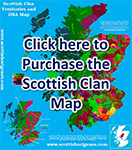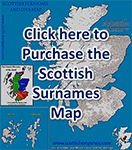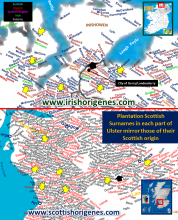You are here
Why the Scots dominate Ulster
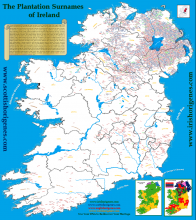 Introduction (Updated September 2022)
Introduction (Updated September 2022)
17th Century Gaelic Ulster was one of the last redouts of the ancient Celtic world. A world that had been eclipsed in Mainland Europe by the Romans over a millennia and a half earlier. The final Conquest of Ireland would see the Irish Gaels dragged kicking and screaming into the modern world (the Highland Scots Gaels would cling on for another century). It was a traumatic process, and one can only imagine how the Native Ulster Irish felt seeing the arrival of thousands of English speaking, Protestant, Lowland Scots, and English. The consequences of the Plantation of Ulster are still being felt today. But what does the first ever Plantation Surnames of Ireland Map (now free to explore online click here) and the hundreds of Northern Irish DNA Case Studies reveal about the Plantation of Ulster?
The Scots dominate the Plantation Surnames of Ireland Map, but the Scots themselves were a mixed bunch of predominantly Lowland Gaels (with ‘Mac’ surnames) and non-Gaels who mostly originated from Southwest Scotland and the Southernmost borderlands with England. A recent set of Y-DNA Case Studies on the Plantation Donegal ‘Allisons’ and County Down ‘Ellisons’ (CLICK HERE to download the Ellison Y-DNA Case Study) 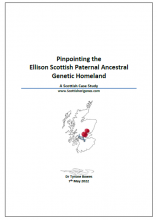 reveals that they descended from paternal cousins who departed Strathaven parish in Lanarkshire in Southern Scotland in around 1610AD. One cousin settled in County Donegal where the surname remained Allison, while the other settled in Down where the surname became Ellison. Both settled with neighbours from Strathaven parish and the surrounding borderlands of Ayrshire and Lanarkshire. These were close knit communities that would often repeat a pattern of migration and settlement as more land became available until almost all of Ulster was colonised. In Ireland they would evolve into the Scots Irish or Ulster Scots.
reveals that they descended from paternal cousins who departed Strathaven parish in Lanarkshire in Southern Scotland in around 1610AD. One cousin settled in County Donegal where the surname remained Allison, while the other settled in Down where the surname became Ellison. Both settled with neighbours from Strathaven parish and the surrounding borderlands of Ayrshire and Lanarkshire. These were close knit communities that would often repeat a pattern of migration and settlement as more land became available until almost all of Ulster was colonised. In Ireland they would evolve into the Scots Irish or Ulster Scots. 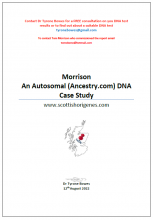 The tight kinship of these Scottish is even better illustrated in the Morrison Autosomal DNA Case which is based on Ancestry.com DNA test results (CLICK HERE to download the Morrison Ancestry.com Autosomal DNA Case Study). The Morrison Case Study beautifully illustrates how many of his ancestral lines link back to the same part of Ulster and in turn back to the same part of Scotland ('safety in kinship and numbers'). The Scots that passed through Ireland would become excellent frontiersmen as a result of living among often hostile Native Irish. A few generations after their arrival in Ulster, their descendants would depart for the Americas, repeating that same pattern of settlement in the New World.
The tight kinship of these Scottish is even better illustrated in the Morrison Autosomal DNA Case which is based on Ancestry.com DNA test results (CLICK HERE to download the Morrison Ancestry.com Autosomal DNA Case Study). The Morrison Case Study beautifully illustrates how many of his ancestral lines link back to the same part of Ulster and in turn back to the same part of Scotland ('safety in kinship and numbers'). The Scots that passed through Ireland would become excellent frontiersmen as a result of living among often hostile Native Irish. A few generations after their arrival in Ulster, their descendants would depart for the Americas, repeating that same pattern of settlement in the New World.
 Passing through Ireland led to the first corruptions of a number of other Scottish surnames, with Irish ’McReynolds’ replacing Scottish ‘McCrindle,’ ‘Roxborough’ becoming ‘Roseberry,’ and 'Hemphill' replacing 'Semple' (see Hemphill Case Study click here). While Y-DNA testing would dispel some common held myths, the Ulster ‘Mahargs’ are NOT ‘Grahams in disguise’ but are Southwest Scottish Gaelic ‘McHarg’ (Maharg = Graham spelled backwards). Similarly, Ulster 'Hawthornes' are not Gaelic Irish ‘O’Dreains’ but Southwest Scottish ‘Hawthorns,’ while both Northern Irish and Scottish ‘Littles’ were originally Border Scot ‘Liddells.
Passing through Ireland led to the first corruptions of a number of other Scottish surnames, with Irish ’McReynolds’ replacing Scottish ‘McCrindle,’ ‘Roxborough’ becoming ‘Roseberry,’ and 'Hemphill' replacing 'Semple' (see Hemphill Case Study click here). While Y-DNA testing would dispel some common held myths, the Ulster ‘Mahargs’ are NOT ‘Grahams in disguise’ but are Southwest Scottish Gaelic ‘McHarg’ (Maharg = Graham spelled backwards). Similarly, Ulster 'Hawthornes' are not Gaelic Irish ‘O’Dreains’ but Southwest Scottish ‘Hawthorns,’ while both Northern Irish and Scottish ‘Littles’ were originally Border Scot ‘Liddells.
 What happened to the Gaelic Irish?
What happened to the Gaelic Irish?
With the arrival of the Plantation Scots and English, the Native Irish faced the prospect of assimilation or displacement. A surprising number of Irish clans, particularly in Counties Antrim and Down where Plantation settlement was most successful did indeed assimilate and are today indistinguishable from their fellow Protestants. The only evidence of their Irish origin is in their Y-DNA test results and their surnames like Branagh, Brennan, Gorman, Heaney, and Connor which have no Scottish or English equivalent. 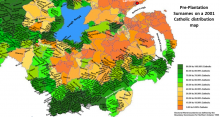 The numbers are significant and point to a mini–Irish Reformation which has surprisingly disappeared from recorded history. However, for the majority ‘unassimilated’ Irish, simmering sectarian issues would be amplified over time, a process that would see them gravitate to areas where they were more numerous (safety in numbers), giving rise to areas of Ulster that are almost devoid of Gaelic Irish surnames, a process most notable today in Counties Armagh and Down.
The numbers are significant and point to a mini–Irish Reformation which has surprisingly disappeared from recorded history. However, for the majority ‘unassimilated’ Irish, simmering sectarian issues would be amplified over time, a process that would see them gravitate to areas where they were more numerous (safety in numbers), giving rise to areas of Ulster that are almost devoid of Gaelic Irish surnames, a process most notable today in Counties Armagh and Down.
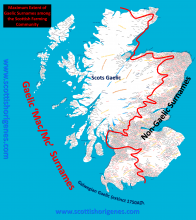 A Gaelic Irish origin for many Plantation Scots
A Gaelic Irish origin for many Plantation Scots
If you ask anyone today to point out the Gaelic area of Scotland they will point to the Highlands and Western Isles. Yet if one divides Scotland based on the distribution of Gaelic ‘Mac’ surnames it reveals an almost perfect East/West divide. Everyone neglects the Gaelic Southwest which includes Galloway and parts of bordering Ayrshire and Southern Lanarkshire. Y-DNA testing reveals that there are in fact 2 Gaelic Paternal Y-DNA markers associated with Southwest Scotland; I-M223 and R-M222. The I-M223 marker is associated with Gaulish refugees from Roman Conquest who settled in Southwest Scotland and spread into Southern Ulster in Ireland. In contrast, the R-M222 mutation appeared in a single male who lived in Northwest Ireland in around 200AD. The descendants of R-M222-Adam would proliferate in Ireland and in 1100AD some would participate in the Hiberno-Norse Conquest of Southwest Scotland. 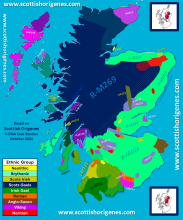 The land in Southwest Scotland that these Irish Gaels Conquered became ‘Galloway’ or ‘land of the foreign Gael,’ a term used by the surrounding Scots to describe these Irish Gaelic colonisers. Overtime, the Irish Gaels would be absorbed among the Scottish Gaels, some would adopt the English language and become Protestant. Over 500 years later in 1610AD, many of these bilingual Protestant Scots Gaels from Galloway would return to Ireland as colonisers. Hence today, many of the Protestant community of Ulster with Gaelic Scottish surnames have an Irish paternal R-M222 genetic marker (making them more Irish than some of the surrounding Irish Catholics). Although the Galloway Gaels were of different faith, they shared a common Gaelic language and had a mutual historical loathing of the English. That would have consequences in the 1641 rebellion.
The land in Southwest Scotland that these Irish Gaels Conquered became ‘Galloway’ or ‘land of the foreign Gael,’ a term used by the surrounding Scots to describe these Irish Gaelic colonisers. Overtime, the Irish Gaels would be absorbed among the Scottish Gaels, some would adopt the English language and become Protestant. Over 500 years later in 1610AD, many of these bilingual Protestant Scots Gaels from Galloway would return to Ireland as colonisers. Hence today, many of the Protestant community of Ulster with Gaelic Scottish surnames have an Irish paternal R-M222 genetic marker (making them more Irish than some of the surrounding Irish Catholics). Although the Galloway Gaels were of different faith, they shared a common Gaelic language and had a mutual historical loathing of the English. That would have consequences in the 1641 rebellion.
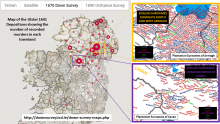 The 1641 rebellion and its aftermath
The 1641 rebellion and its aftermath
We live in an age when every atrocity of war is recorded so that justice can be sought at a later date. The precedent for which is the 1641 rebellion in Ireland. Every single murder and massacre was recorded in detail (Down Survey), and includes the names of the perpetrators and their victims. It is a remarkable piece of history (which for generations would stoke the sectarian flames), even more remarkable when one realises on can explore each incident at the click of a button. After making the first ever Plantation Surnames of Ireland map, I was struck almost immediately by the fact that the 2 areas where most atrocities occurred were associated with English settlement (North and West Armagh, and Mid-Cavan) where English surnames dominate. 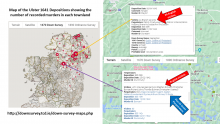 There was no love lost between Scots and English settlers in Ireland. One could argue that the people of Scotland and English have been at each other’s throats since Roman times. However, the English colonisers were at a disadvantage as they did not speak Gaelic, while many of the Scots could (having originated in Scottish Gaelic Galloway). In addition, many Scots were still aware of their deeper connections with Ireland, as were many of the Native Irish. This resulted in the targeting of English settlers in 1641, with some recorded instances of the Scots also taking an active part. However, when order was restored, it was the Irish who suffered, while the Scots would simply acquire extra land left by the absent Irish and English. This could be one reason why the Scots far outnumber the English in Ulster.
There was no love lost between Scots and English settlers in Ireland. One could argue that the people of Scotland and English have been at each other’s throats since Roman times. However, the English colonisers were at a disadvantage as they did not speak Gaelic, while many of the Scots could (having originated in Scottish Gaelic Galloway). In addition, many Scots were still aware of their deeper connections with Ireland, as were many of the Native Irish. This resulted in the targeting of English settlers in 1641, with some recorded instances of the Scots also taking an active part. However, when order was restored, it was the Irish who suffered, while the Scots would simply acquire extra land left by the absent Irish and English. This could be one reason why the Scots far outnumber the English in Ulster.
Another interesting DNA fact revealed by the turbulent times of 1641 is that many orphaned English, Irish, and Scots children were simply adopted into Planter or Native Irish families and assumed new identities, which has given rise to an unusual number of DNA Case Studies were non-paternal events are revealed (where a surname and family history does not match the DNA). For anyone DNA testing in Ulster the results can be a lottery, which from a science perspective makes Ulster DNA so fascinating! Which begs the question, what would the DNA of today’s Ulster Politicians reveal?
CLICK HERE to contact Scottish Origenes for a FREE CONSULTATION on your DNA test results or to find out about a suitable DNA test or email Dr Tyrone Bowes: tyronebowes@gmail.com
Where will your DNA take you?


